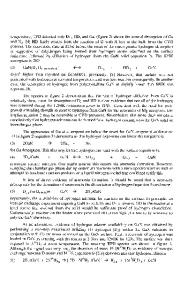Milling and Additive Effects on Hydrogen Desorption Reactions of Li-N-H and Li-Mg-N-H Hydrogen Storage Systems
- PDF / 122,215 Bytes
- 6 Pages / 612 x 792 pts (letter) Page_size
- 99 Downloads / 421 Views
0971-Z07-02
Milling and Additive Effects on Hydrogen Desorption Reactions of Li-N-H and Li-Mg-N-H Hydrogen Storage Systems Mitsuru Matsumoto1, Yoshitsugu Kojima1,2, Shin-ichi Towata1, Yuko Nakamori3, and Shin-ichi Orimo3 1 Toyota Central R&D Labs. Inc., Nagakute, Aichi, 480-1192, Japan 2 Hiroshima University, Higashi Hiroshima, Hiroshima, 739-8530, Japan 3 Institute for Materials Research, Tohoku University, Sendai, 980-8577, Japan
ABSTRACT Hydrogen desorption reactions of the mixtures of (i) lithium amide and lithium hydride (LiNH2/LiH), and (ii) magnesium amide and lithium hydride (Mg(NH2)2/4LiH) were studied. Titanium compounds and nano-particles including fullerene (C60), were doped to those hydrogen storage mixtures respectively. The hydrogen desorption reactions were monitored by means of temperature programmed desorption (TPD) technique under an Ar atmosphere. The reaction of LiNH2/LiH was accelerated by adding either 1 mol% of Ti species or 0.2 mol% of fullerene (C60), while those additives did not show significant acceleration effects on the reaction of Mg(NH2)2/4LiH. Kinetic studies revealed the enhanced hydrogen desorption reaction rate constant for TiCl3 doped LiNH2/LiH, k = 3.1 x 10-4 s-1 at 493 K, and the prolonged ball-milling further improved reaction rate, k = 1.1 x 10-3 s-1 at the same temperature. For the dehydrogenation reaction of TiCl3 doped LiNH2/LiH, the activation energies estimated by Kissinger plot (95 kJ mol-1) and Arrhenius plot (110 kJ mol-1) were in reasonable agreement each other. The LiNH2/LiH mixture without additive exhibited slower hydrogen desorption process and the kinetic traces deviated from single exponential behavior. The results indicated the Ti(III) additives change the hydrogen desorption reaction mechanism of LiNH2/LiH. INTRODUCTION Hydrogen storage materials for hydrogen fuel cell powered automobile applications have been drawing great attention. Among various storage techniques, the use of hydrogen desorption/absorption reaction cycle of complex hydrides is one of the candidates to compose a light-weight hydrogen tank because of the large gravimetric H2 capacity [1-4]. After Chen proposed the Li-N-H system as a hydrogen storage material, the LiNH2/LiH mixture (equation 1), and the Mg(NH2)2/LiH mixture (equation 2) have been extensively studied [5-10]. Li3N + 2H2 ⇄ Li2NH + LiH + H2 ⇄ LiNH2 + 2LiH Mg3N2 + 4Li3N 12H2 ⇄ 3Mg(NH2)2 + 12LiH
(1) (2)
Equation 1 and 2 indicate the available H2 reaches 10.4 and 9.1 wt. % of the starting materials, and H2 is rechargeable in the both systems. Those reactions, however, remain rather impractical for on-board applications because they demand high temperature, low dissociation pressure, and extensive reaction time. In present work we studied the additive and ball-milling effects on the hydrogen desorption kinetics of those reactions.
EXPERIMENT Lithium amide (LiNH2, 95%) and lithium hydride (LiH, 95%) were purchased from Sigma-Aldrich and used without further purification. Mg(NH2)2 was synthesized from MgH2 and NH3. LiNH2 and LiH
Data Loading...











